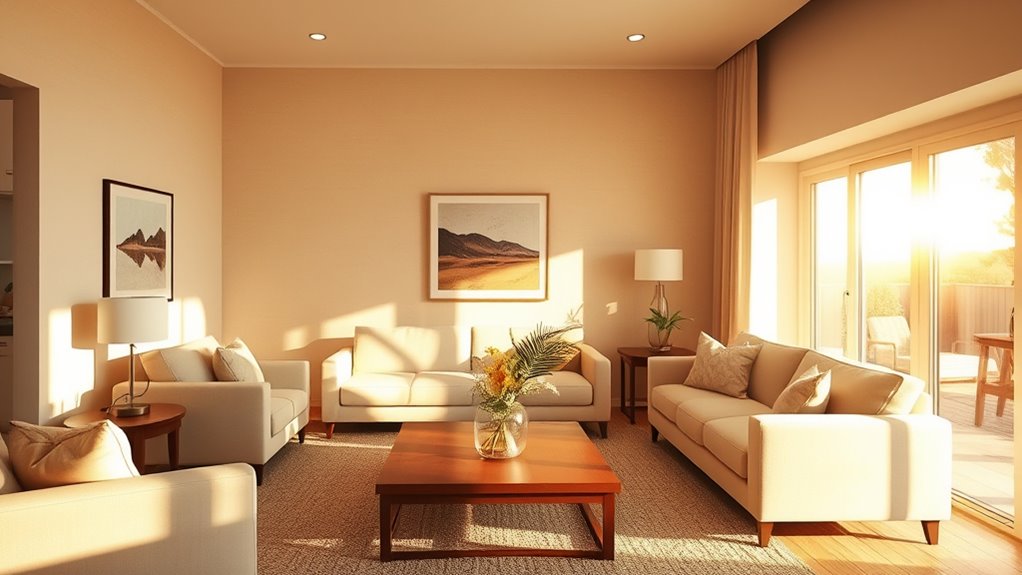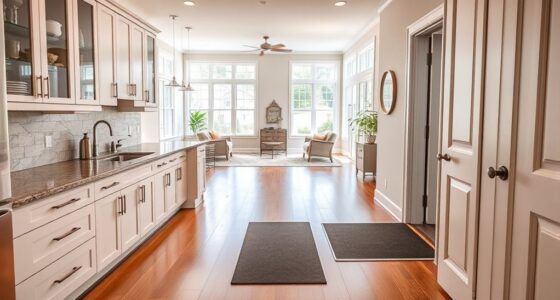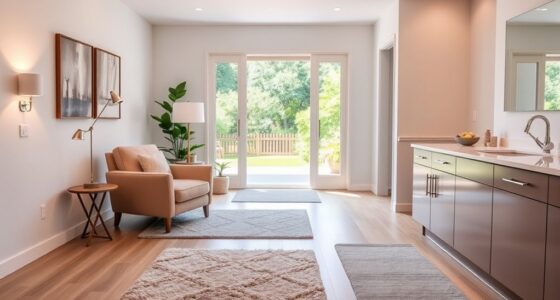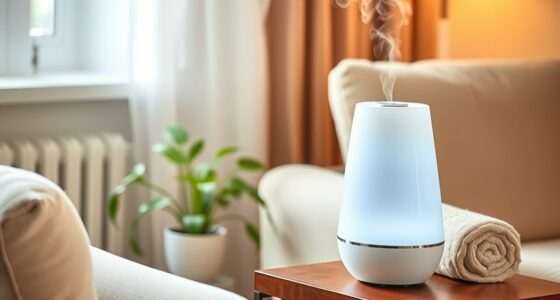Improving your home lighting is a simple yet powerful way to boost comfort, energy efficiency, and ambiance. By evaluating your current setup, adding brighter, energy-efficient fixtures, and focusing on targeted task lighting, you can make your space feel more inviting and functional. Proper lighting reduces shadows, enhances visual comfort, and creates a cozy atmosphere. Keep exploring to discover easy fixes that can transform your home’s environment effortlessly.
Key Takeaways
- Upgrading to energy-efficient LED fixtures enhances brightness and reduces energy costs effortlessly.
- Proper assessment identifies dark spots and outdated fixtures needing simple replacements or additions.
- Combining ambient and task lighting creates a balanced, inviting, and functional home environment.
- Targeted task illumination improves visibility in specific areas like kitchens and reading nooks.
- Well-placed lighting reduces shadows and eye strain, making spaces more comfortable and visually appealing.

Good lighting can transform your home, making it more inviting, functional, and energy-efficient. When you pay attention to how your space is lit, you can instantly improve its overall atmosphere and usability. One of the simplest yet most effective ways to do this is by balancing ambient brightness with targeted task illumination. Ambient brightness provides the general, soft light that fills a room, setting the mood and making sure you can see comfortably without harsh shadows. Task illumination, on the other hand, focuses on specific areas where you need clear, direct light—like reading nooks, kitchen counters, or workspaces. By combining these two types of lighting strategically, you create a space that’s both cozy and practical.
Start by evaluating your current lighting setup. Do you rely solely on ceiling fixtures that cast a uniform glow, or do you have dark corners and poorly lit work areas? If your rooms feel dim or uneven, you need to boost ambient brightness first. This might mean replacing outdated fixtures with brighter, energy-efficient LED options or adding additional sources of soft light, like wall sconces or floor lamps. The goal is to create an even, welcoming glow that fills the room without overpowering it. When ambient brightness is just right, the space feels open and comfortable, inviting you to relax or entertain without the need for additional lighting.
Next, focus on task illumination. Identify the areas where you perform specific activities—cooking, reading, working—and ensure those spots have dedicated, adjustable lighting. For kitchens, under-cabinet lights can brighten countertops, making meal prep safer and easier. In a home office or reading nook, a well-placed desk lamp or adjustable task light ensures you can see details clearly without straining your eyes. The key is flexibility; you want lighting that can be directed exactly where you need it, rather than relying solely on general overhead fixtures. This targeted approach not only improves functionality but also helps you save energy, since you won’t need to keep the entire room brightly lit when only specific areas require illumination.
In addition, understanding how sound vibrations influence cellular health can inspire the use of calming music or sound-based lighting effects to enhance relaxation in your space. Combining ambient brightness and task illumination isn’t just about aesthetics; it’s about creating a space that works for you. When your lighting is well-balanced, you’ll notice less eye strain, better focus, and a more welcoming environment overall. It’s a simple home fix that doesn’t demand a major renovation, but it makes a significant difference. With just some strategic placement and the right bulbs, you’ll enhance your home’s ambiance, boost its practicality, and enjoy an energy-efficient living space that feels just right.
Frequently Asked Questions
How Can I Determine the Best Lighting Temperature for My Space?
To determine the best lighting temperature for your space, consider your preferred lighting color and ambient illumination. Cooler temperatures (around 5000K) create a bright, energetic feel, ideal for workspaces. Warmer temperatures (around 2700K) offer a cozy, relaxing atmosphere, perfect for living rooms or bedrooms. Test different bulbs to see how each affects your space’s ambiance, and choose the one that enhances your comfort and desired mood.
What Are Cost-Effective Options for Upgrading Home Lighting?
You can upgrade your home lighting cost-effectively by choosing smart bulbs, which let you control brightness and color temperature via apps or voice commands, saving energy and enhancing ambiance. Installing dimming switches is another budget-friendly option, giving you adjustable lighting without replacing fixtures. These upgrades are easy to implement and can considerably improve your space’s comfort and efficiency, all while keeping costs manageable.
How Does Improved Lighting Impact Energy Consumption?
Think of your home as a garden; better lighting acts like sunlight, helping you see clearly while saving energy. When you upgrade to efficient bulbs, you reduce your energy consumption, leading to significant energy savings. This not only cuts your bills but also lessens your environmental impact. Brightening your home thoughtfully makes a big difference, turning a simple upgrade into a powerful step toward a more sustainable lifestyle.
Can Better Lighting Help Improve Mood and Productivity?
Better lighting can considerably improve your mood and productivity. When you have well-designed lighting, it enhances mood enhancement by creating a warm, inviting atmosphere, reducing stress, and boosting your overall well-being. Additionally, improved lighting supports a productivity boost by reducing eye strain and increasing focus. You’ll find it easier to stay motivated and efficient throughout your day, making your home environment more comfortable and conducive to work and relaxation.
What Safety Considerations Should I Keep in Mind When Upgrading Lighting?
When upgrading your lighting, you should prioritize electrical safety to prevent fire hazards. Always turn off power before installing new fixtures, and use qualified electricians for complex wiring. Avoid overloading circuits, and make sure bulbs match the recommended wattage. Check for exposed wiring or loose connections, as these pose fire risks. Properly secure fixtures and use certified components to keep your home safe while enhancing your lighting.
Conclusion
By upgrading your home lighting, you create a brighter, more welcoming space. Imagine replacing dull bulbs with energy-efficient LEDs and instantly seeing your living room come alive, making it easier to read, cook, or relax. For example, Sarah did just that and noticed her mood lift, plus her electricity bill drop. Small changes like improved lighting can make a big difference—so go ahead, brighten up your home and enjoy the positive impact it brings!









